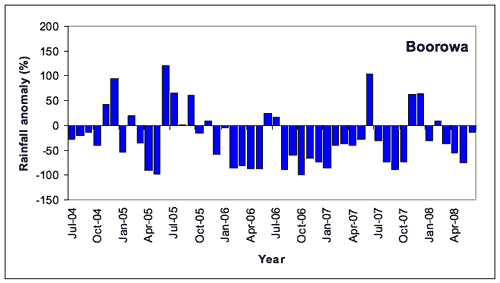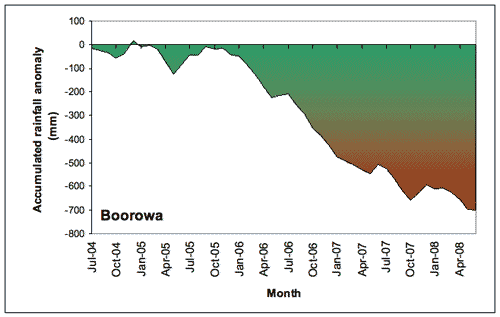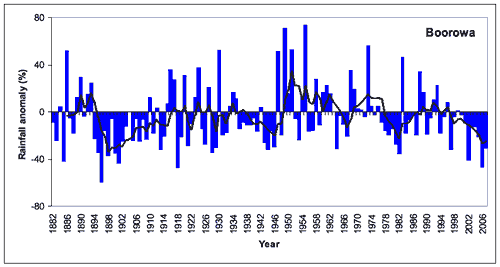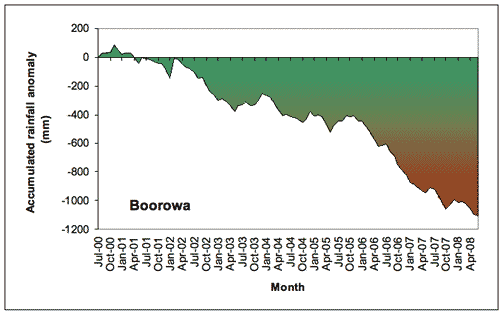Boorowa
Rainfall Analysis
The main rainfall observing site used in this analysis was Boorowa Post Office (Bureau of Meteorology Station No. 070220), which has records commencing in 1882. Data from the nearby station at Murringo were used to calculate values for months with missing data at this site (see Appendix 2 for further information).
Note that in the following analyses rainfall totals for individual months or years (where the year is defined as the 12 months from July to June) are compared to the long-term average (or climatology) from 1961-1990. A 30-year period is used to calculate climatological averages to conform with World Meteorological Organisation practice; this takes into account year-to-year variations and less frequent events such as El Niño or La Niña. This particular 30-year period is used internationally as a standard climatological average period.
As shown in the table below, Boorowa was drier than average for all four years in the period 2004/05-2007/08. The driest year was 2006/07, when rainfall was 46.3% below the long-term average at 341.1 mm for the year. This was the third driest Jul-Jun 12-month period since records at Boorowa began in 1882. The wettest year in the last four years was 2004/05, although the 554.4 mm received was 12.8% below the long-term annual average.
Table 1. Annual rainfall statistics at Boorowa, 2004/05-2007/08
| Rainfall Statistics | Boorowa |
|||
|---|---|---|---|---|
| 2004/5 | 2005/6 | 2006/7 | 2007/8 | |
| Annual Total* (mm) | 554.4 | 500.2 | 341.4 | 441.4 |
| Anomaly (mm) | -81.6 | -135.8 | -294.6 | -194.6 |
| Anomaly (%) | -12.8 | -21.4 | -46.3 | -30.6 |
| Mean (1961-1990) (mm) | 636.0 | |||
*Note: annual totals were calculated for the 12 months July-June.
Monthly Rainfall, 2004-2008
A comparison of monthly rainfall totals with the long-term monthly average rainfall at Boorowa (Figure 1) shows that most of the period experienced below-average rainfall, with the exception of December 2004-January 2006, November 2007 and February 2008. Generally dry conditions were experienced between July 2004 and May 2005, followed by very dry conditions between February 2006 and October 2007 (with the exception of three wet months in that time). These very dry conditions reflect the impact of the El Niño event during 2006/07 while the increase in rainfall at the end of 2007 reflects the development of a La Niña event. Dry conditions returned for the period March to June 2008.
Figure 1. Boorowa monthly rainfall totals (blue bars) compared with the long-term monthly mean rainfall shown in yellow (all in mm) July 2004-June 2008.

Of the 48 months in this period, 34 months (71% of the record) had below-average rainfall at Boorowa (Figure 2). The most prolonged dry spell began in December 2005 and extended to October 2007. During this period there were only 3 months with above average rainfall and 20 months with below average rainfall, most with extremely dry conditions. Rainfall from June 2004 to May 2005 was generally below average, whereas June 2005 to November 2005 and November 2007 to March 2008 were generally wetter. Dry conditions returned in autumn 2008. The driest individual month was October 2006, with 0 mm (the long-term average for October is 60 mm), and only 1 mm was recorded in May 2005 (long term average 56.1 mm). The wettest month was December 2004 with 107.6 mm (long term average 55.2 mm).
 |
The result of the generally dry conditions at Boorowa during the period 2004-2008 can be seen in Figure 4, which shows the accumulated rainfall deficit over this period. While accumulated rainfall was close to the norm from June 2004 to November 2005, a rainfall deficit increased sharply during 2006/07 and continued to increase until the end of the analysis period. Rainfall deficits occurred in 25 of the 31 months from December 2005 to June 2008. The total rainfall deficit for the four year period was 701 mm (110% of the Jul-Jun average rainfall). These dry conditions reflect the impact of the El Niño event that was experienced during 2006/07.
 |
The climatological context for rainfall at Boorowa
The long-term perspective
As is typical of the region, Boorowa has experienced large fluctuations in annual (July-June) rainfall, including several extended periods of above- or below-average rainfall since records began in 1882. In general, annual rainfall was lower and less variable early in the 20th century, followed by a period of greater variability. Rainfall variability has been lower since about 1980 (Figure 4). The recent dry period has counterparts in other parts of the long term record such as the early part of the 20th century and the period from the late 1920s20 the mid 1940s. To date the recent dry period appears to fall within the range of long term rainfall variability in the region.
 |
- Rainfall in the late 19th and early 20th century was generally below average (to about 1915). The following 20 years was characterised by high variability, after which conditions were dry from the early 1930s to the mid 1940s.
- Several wetter-than-normal years around 1950 and 1960 produced a generally wetter period then.
- A generally drier period around 1980 was followed by variable rainfall until the early 1990s. Since 1997 conditions have been drier than average.
The wettest year (July-June) on record was 1955/56 (1105.4 mm); the driest year was 1896 (255.4 mm).
Figure 5 shows the impact of the dry period from the year 2000. Rainfall deficits increased considerably during 2002, flattened out during 2003/04 then increased again during 2006/07. This reflects the impacts of the two El Niño years in 2002/03 and 2006/07 without a compensating wet period. During the eight-year period there were 65 months (68%) of rainfall deficit; the total accumulated deficit was 1099.8 mm (170% of the average Jul-Jun rainfall).
 |
About the data
